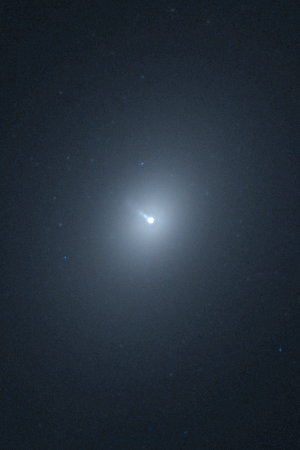| NGC 1218 | |
|---|---|
 NGC 1218 as viewed by the Hubble Space Telescope.[Note 1] | |
| Observation data (J2000.0 epoch) | |
| Constellation | Cetus |
| Right ascension | 03h 08m 26.2s[1] |
| Declination | +04° 06′ 39.3″[1] |
| Redshift | 0.0288[2] |
| Heliocentric radial velocity | 8,485±15 km/s[3] |
| Galactocentric velocity | 8,488±15 km/s[3] |
| Distance | 378,600,000 ly (116.08 Mpc)[1] |
| Group or cluster | [CHM 2007] LDC 223[1] |
| Apparent magnitude (V) | 8.460[3] |
| Apparent magnitude (B) | 12.84[4] |
| Absolute magnitude (V) | -2.70[3] |
| Surface brightness | 1.19×10−1[3] |
| Characteristics | |
| Type | S0/a[3] |
| Size | 225,400 ly (69.11 kpc) (diameter)[3] |
| Apparent size (V) | 1.147′ × 0.917′[1] |
| Other designations | |
| Gaia DR1 2673462523030912, 2MASS J03082623+0406390, 2MASX J03082624+0406388, UGC 2555, LEDA 11749, MCG +01-09-001, PGC 011749, CGCG 0305.8+0355[1][3][Note 2] | |
NGC 1218 is a lenticular galaxy in Cetus that hosts the radio source 3C 78. It was discovered in 1886 by American astronomer Lewis A. Swift. It is located at l = 174.86, b = -44.51 in the galactic coordinate system.[1]
Cite error: There are <ref group=Note> tags on this page, but the references will not show without a {{reflist|group=Note}} template (see the help page).
- ^ a b c d e f g "NGC 1218". SIMBAD. Retrieved 2024-04-05.
- ^ Cite error: The named reference
Cen-Awas invoked but never defined (see the help page). - ^ a b c d e f g h "Results for object NGC 1218". NED. Retrieved 2024-04-05.
- ^ "NGC 1218 - Lenticular Galaxy in Cetus". The Sky Live. Retrieved 2024-04-05.